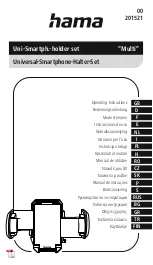
200
APPENDIX
at the same time. This standard was approved by the IEEE in 2000.
FDA continues to monitor the use of wireless phones for possible
interactions with other medical devices. Should harmful interference
be found to occur, FDA will conduct testing to assess the interference
and work to resolve the problem.
12. Where can I find additional information?
For additional information, please refer to the following resources:
x
For FDA web page on wireless phones, visit http://
www.fda.gov/Radiation-EmittingProducts/
RadiationEmittingProductsandProcedures/
HomeBusinessandEntertainment/CellPhones/default.htm).
x
For Federal Communications Commission (FCC) RF Safety
Program, visit http://www.fcc.gov/oet/rfsafety.
x
For International Commission on Non-Ionizing Radiation
Protection, visit http://www.icnirp.de.
x
For World Health Organization (WHO) International EMF Project,
visit http://www.who.int/peh-emf/en/.
x
For National Radiological Protection Board (UK), visit http://www.
hpa.org.uk/radiation/.
AVOID POTENTIAL HEARING LOSS
Prolonged exposure to loud sounds is the most common cause of
preventable hearing loss. Some scientific research suggests that
using portable audio devices, and cellular telephones, at high volume
settings for long durations may lead to permanent noise-induced
hearing loss. This includes the use of headphones (including headsets,
earbuds and Bluetooth® or other wireless devices). Exposure to very
loud sound has also been associated in some studies with tinnitus (a
ringing in the ear), hypersensitivity to sound and distorted hearing.
Individual susceptibility to noise-induced hearing loss and other
potential hearing problems varies.














































